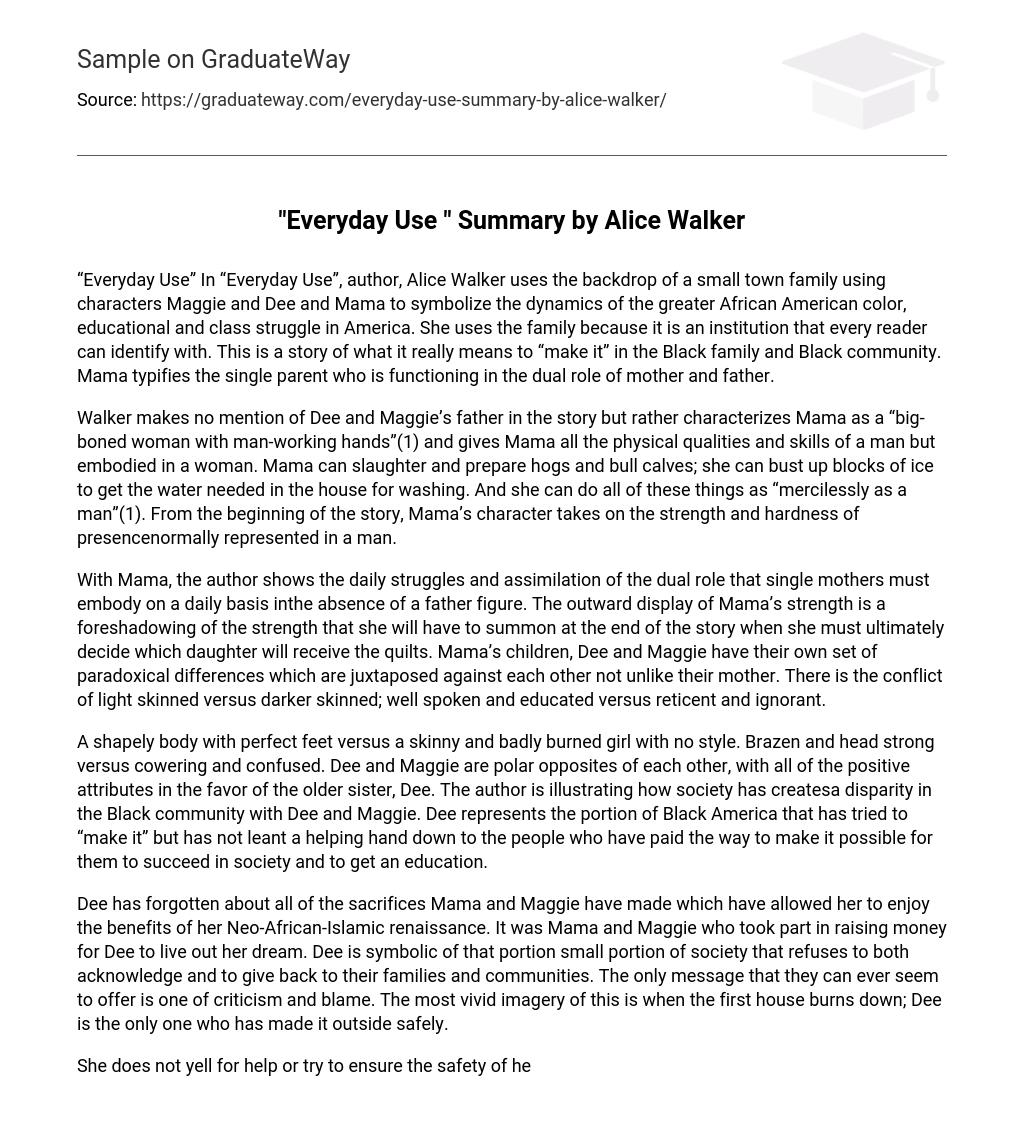In her story “Everyday Use”, Alice Walker explores the dynamics of the African American color, educational, and class struggle in America using the backdrop of a small town family. Through the characters Maggie, Dee, and Mama, Walker symbolizes these struggles and showcases what it truly means to succeed in the Black family and community. By focusing on the family as an institution, the author allows every reader to relate to and understand the challenges faced by these characters. Mama serves as a representation of the single parent who takes on both the roles of mother and father.
In the story, Walker does not mention Dee and Maggie’s father. Instead, Walker describes Mama as a woman with a physical appearance and abilities typically associated with men. Mama has a strong and tough presence, being able to slaughter and prepare animals and perform tasks such as breaking blocks of ice. Mama carries out these tasks with the same ruthlessness as a man would. Right from the start of the story, Mama’s character embodies the strength and hardness usually attributed to men.
With Mama, the author depicts the daily struggles and assimilation of single mothers who must fulfill both parental roles without a father figure present. Mama’s displayed strength foreshadows the inner strength she will need at the end when she must decide which daughter will receive the quilts. Mama’s children, Dee and Maggie, possess contrasting characteristics that mirror their mother’s. They navigate conflicts of skin tone and education, with Dee being light-skinned and educated while Maggie is darker-skinned and less educated.
Dee and Maggie are two contrasting individuals within the Black community. Dee embodies physical attractiveness and grace, accompanied by perfect feet. On the other hand, Maggie is portrayed as a thin girl, scarred by burns, and lacking in style. Furthermore, Dee is bold and self-assured while Maggie appears timid and confused. The author uses these characters to highlight the societal divide within the Black community. Dee exemplifies a segment of Black America that strives for personal success without extending a helping hand to those who paved the way for their own achievements and education.
Dee has disregarded the sacrifices made by Mama and Maggie, which have enabled her to enjoy the advantages of her Neo-African-Islamic rebirth. It was Mama and Maggie who contributed to raising funds for Dee to pursue her aspirations. Dee represents a small segment of society that fails to recognize and support their own families and communities. Their sole communication seems to consist of criticism and blame. The most striking metaphor for this is when the initial house is consumed by fire; Dee is the sole individual who manages to escape unharmed.
Instead of yelling for help or ensuring the safety of her mother and sister, she remains fixated on the flames, seemingly wanting the house and everyone inside to be engulfed. Dee, on the other hand, stands safely in the sweet gum tree while her mother and sister have to run for their lives. Walker reveals the contradiction of someone who, having found safety, lacks empathy for the struggles of her family members. Maggie’s spirit had been broken by the fire in their previous house, symbolizing how she had been beaten down by the world for not being like Dee.
Both Maggie and Mama lacked the good fortune of having a fair complexion like Dee. Maggie had the additional disadvantage of being dark-skinned, which was amplified by the scars she acquired from the house fire. Maggie has come to terms with her lack of intelligence compared to Dee and has resigned herself to a mundane life of poverty. She feels ashamed of her scars and life experiences, causing her to shrink in the presence of strength and societal cruelty. Maggie’s natural inclination is to submit. She acknowledges that she cannot compete with Dee and therefore gives in to Dee’s request for the quilts that Mama had promised to Maggie.
Both Dee and Mama have not recognized Maggie’s abilities and intelligence. Maggie possesses her own unique capability and intelligence. Maggie is the one who is knowledgeable about the family’s history, such as knowing Big Dee’s first husband, Stash, and that he carved the butter dash. She is also observant enough to notice that Dee has never had any friends. Maggie has learned the skill of preserving the family’s heritage through quilting with Grandma Dee and Big Dee. It is mentioned that “Maggie knows how to quilt.” Despite her resourcefulness and knowledge, Maggie’s contributions are never acknowledged when Dee is present.
Dee always outshines Maggie. Maggie’s worth is often overlooked by society because she does not fit our preconceived idea of value. Alice Walker has presented thought-provoking questions for us to consider: how do we determine and assign value? Does skin color still determine access to certain opportunities? To expose what we may be afraid to acknowledge in ourselves and in society, Walker utilizes the family structure, a sanctuary of sorts.





